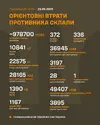Eikös tuo äksyn "secured" tarkoita pikemminkin sitä, että tilaukset on sisässä ja toimitukset tulevat tapahtumaan vuoden loppun mennessä, mutta ei välttämättä vielä toimitettu. Yhtäkaikki, tahti on hyvä.EU toimittanut Ukrainalle 2/3 vuoden 2025 murkulatavoitteesta (2 miljoonaa 155 mm).
Tässä lajissa Eurooppa on päässyt hyvälle tasolle.
Install the app
How to install the app on iOS
Follow along with the video below to see how to install our site as a web app on your home screen.
Note: This feature may not be available in some browsers.
You are using an out of date browser. It may not display this or other websites correctly.
You should upgrade or use an alternative browser.
You should upgrade or use an alternative browser.
Ukrainan konflikti/sota
Hienoja uutisia! 

 www.iltalehti.fi
www.iltalehti.fi


Venäjältä loppuu öljy
Venäjän hyödynnettävissä olevat öljyvarat ehtyvät nykytahdilla alle 30 vuodessa.
Onhan tuossa taas vähän sensaatiohakuista otsikointia. Ukraina sai ensimmäiset Himarsit 23.7.2022. Tällä tahdillahan ne loppuu jo vuonna 2054. Pakko luovuttaa!Yksi Himars-auto maksaa about saman mitä vajaa puolitusinaa salvoja siihen. Yhdessä setissä muistaakseni kuusi rakettia. Pisimmälle lentäviä settejä taisi saada ehkä kolme. Sota on kallista, eikä näiden perään kannata itkeä sen enempää.
En osta eikä varmaan moni muukaan ajatusta, että ryssän tarvitsisi NATO-rajaa turvata. Koko sodan ajan raja on ollut tyhjä eikä tulevaisuudessakaan mitään uhkaa tältä suunnalta tule. Jos ei nyt ryssäkään pysty NATO-naapureitaan painostamaan, enää edes Suomea.En tiedä olenko realisti, pessimisti, idiootti vai optimisti mutta sellainenkin on käynyt mielessä että kreml voi tunnistaa että heidän operaationsa Ukrainassa ei etene, sinne kohdistetaan enää rajallisesti resursseja ja uudisrakennuksista suunnataan paras ja modernein kalusto niille alueille missä strateginen paino heidän mielestä (NATO:n raja. Kiinan raja jne) tarvitaan. Tämän seurauksena Ukrainan sota säilyisi vielä pitkään mutta asteteittain viilenevänä konfliktina joka syö länneltä resursseja ja vie huomiota muualle. Sitten jossain vaiheessa maailman mielenkiinto kääntyy muualle ja zenäjälle jää sillä hetkellä heille vallatut maa-alueet joista voivat puhua sisäisesti suurena voittona (mainitsematta niiden järjetöntä hintaa).
Kiinan rajan ryssä itsekin tietänee ongelmaksi. Ja voi hyvin käydäkin niin, että Taiwanin sijaan kiina päättää laajentua Siperian suuntaan.
Mahdollista jossain määrin ehkä jäädyttää sotaa, mutta Euroopan kapasiteetin noustessa se voi käydä kalliiksi ottaa murkulaa vastaan vaikka ei enää hyökkäsi.
Edelleen, tuon täytyy olla fuulaa, että ryssä oikeasti tuntisi noin. Noin toki sanotaan ja sillä tavoin perustellaan tarvetta milloin millekin.Ehkä tuossa ajattelussani on joku kulma mitä en tunnista mutta zenäjän voisi kuvitella pelaavan kuitenkin laajempi kenttäistä peliä jossa se ei voi laittaa liikaa painopistettä yhteen laitaan koska kokee lähes eksistenttiaalista uhkaa mielessään 360 asteiselta sektorilta ympäriltään.
Eksistentiaalinen uhka ryssän mafiahallinnolle on vapaa markkinatalous ja toimiva yhteiskunta. Jos Ukraina pääsee osaksi länttä ja alkaa rikastua Baltian ja Puolan tavoin, sitä voi olla lopulta hankalaa selittää puuceissä sammaleen pyyhkiville ryssille. Koska kuitenkin 40-miljoonaisen Ukrainan perheillä on paljon siteitä ryssälään ja niiden rikastuminen huomattaisiin kyllä.
Eiköhän siitä tule myös jotain reunaehtoja millainen sopimus ryssän olisi saatava, jotta homman voisi lopettaa. Jos Ukraina pääsee osaksi länttä, rikastumista ei voi estää.
Ryssiminen on erityistaito, jota venäläisillä on joka tilanteeseen. Se mikä jää ryssimättä voidaan sitten juosten kusta.Olipa jännä, et tuo maalaus hommakin ryssittiin..
taantumu
Ylipäällikkö
Putin kertoi päättäneensä luoda puskurivyöhykkeen Venäjän ja Ukrainan rajalle. Mitä tällä puskurivyöhykkeellä tarkoitetaan Putin ei tarkemmin kertonut mutta sen tekeminen on armeijan vastuulla.
https://tass.ru/politika/24021137Putin announced the decision to create a buffer zone along the border with Ukraine
MOSCOW, May 22. /TASS/. A decision has been made to create a security buffer zone along the border between the Russian Federation and Ukraine. Russian President Vladimir Putin announced this at an operational meeting with members of the government.
According to the Russian leader, the task is being carried out by the Russian armed forces.
Putin noted that, given the situation in the border regions, it is necessary to restore and rebuild everything that was destroyed, and where security considerations allow, to help return to their native settlements. In addition, it is important to restore infrastructure, support small businesses, and the work of industrial and agricultural enterprises.
On kyllä niin hauskasti valittu sanat että voi olla tilattu tai toimitettu, mutta kuitestkin kaikki 2mil 2025 . ja 2/3 osa on toteutunut niin voisiko olla olla että sen verran on toimitettu 2 mil. Yleensä toi secured tarkoitaa vain varmaa toimitusta/tilausta.Eikös tuo äksyn "secured" tarkoita pikemminkin sitä, että tilaukset on sisässä ja toimitukset tulevat tapahtumaan vuoden loppun mennessä, mutta ei välttämättä vielä toimitettu. Yhtäkaikki, tahti on hyvä.
Komissaario Beck
Alikersantti
Jep, enää vajaa 30 vuotta ja sitt se on siinä.Hienoja uutisia!

Venäjältä loppuu öljy
Venäjän hyödynnettävissä olevat öljyvarat ehtyvät nykytahdilla alle 30 vuodessa.www.iltalehti.fi

Solidsnake
Respected Leader
Juu, ja se sahahorova mikälie on uusi joan d arcJep, enää vajaa 30 vuotta ja sitt se on siinä.

Putin kertoi päättäneensä luoda puskurivyöhykkeen Venäjän ja Ukrainan rajalle. Mitä tällä puskurivyöhykkeellä tarkoitetaan Putin ei tarkemmin kertonut mutta sen tekeminen on armeijan vastuulla.
https://tass.ru/politika/24021137
Putin on uhannut perustaa "puskurivyöhykkeen" Ukrainaan ainakin 8 (!) kertaa.
 Tämä tapahtui ensimmäisen kerran 13.6.2023.
Tämä tapahtui ensimmäisen kerran 13.6.2023. Tuolloin hän sanoi: Jos Ukrainan asevoimat pommittavat Venäjän federaation, "puskurivyöhyke" perustetaan;
 18.3.2024 – sanoi taas saman asian;
18.3.2024 – sanoi taas saman asian; 17.5.2024 kerrottiin, että Venäjä oli jo perustamassa puskurivyöhykettä Harkovan alueelle;
17.5.2024 kerrottiin, että Venäjä oli jo perustamassa puskurivyöhykettä Harkovan alueelle; 28.5.2024 "terveysvyöhykkeellä" oli toinen uhka – tällä kertaa pitkän kantaman aseet;
28.5.2024 "terveysvyöhykkeellä" oli toinen uhka – tällä kertaa pitkän kantaman aseet; 20.6.2024 – sanoi: Harkovin alueelle perustetaan väitetysti "terveysvyöhyke";
20.6.2024 – sanoi: Harkovin alueelle perustetaan väitetysti "terveysvyöhyke"; 31.3.2024 tammikuuta 2024 – mainitsee "demilitarisoidun vyöhykkeen" (olemus on sama).
31.3.2024 tammikuuta 2024 – mainitsee "demilitarisoidun vyöhykkeen" (olemus on sama). 12.3.2025 – ehdottaa turvavyöhykkeen perustamisen harkitsemista.
12.3.2025 – ehdottaa turvavyöhykkeen perustamisen harkitsemista.Keskussotilaspiirin johtajan Kovalenkon mukaan tämä on vain osoitus siitä, että Venäjä ei ole valmis lopettamaan tulitaukoa.
Tässä hyvä ehdotus:
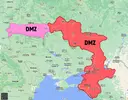
Antares
Respected Leader

Moskovalla voi olla 3300 panssarivaunua vuonna 2027 – vai voiko? | Verkkouutiset
Moskovalla voi olla 3300 panssarivaunua vuonna 2027 – vai voiko? | Verkkouutisetwww.verkkouutiset.fi
Tuossa artikkelissa lainataan tätä IISS:n raporttia (julkaistu 15.5.2025):
https://www.iiss.org/research-paper...ut--the-united-states-costs-and-consequences/
-
Tässä raportin sivulta 10 löytyy tällainen taulukko:
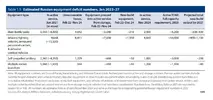
IISS ja sen julkaisema Military Balance on saanut aiheellisesti kritiikkiä mm. Venäjän asevoimien kaluston numeroiden osalta, mutta on silti mielenkiintoista nähdä, mikä on heidän arvionsa ryssän varastotukikohtien tyhjentymästä sekä kalustotappioista Ukrainan sodan aikana.
Jokainen voi toki arvioida itse, muihin lähteisiin / arvioihin verraten, kuinka luotettavia nämä IISS:n numerot ovat.
Omien lähteidensä lisäksi tässä mainitaan, että tätäkin ketjua lukeville tutut twitterin OSINT-tilit Jompy, Highmarsed ja Covert Cabal ovat osaltaan vaikuttaneet tämän taulukon koostamiseen (arvaan että heidän julkaisemansa numerot, eivät niinkään he itse ole olleet mukana).
Jompy kirjoitti tällaista kuusi kuukautta sitten ja huomautti että tämän alla olevan taulukon numeroista osa perustui jo tuolloin yli 6 kuukautta vanhoihin satelliittikuviin (tässä pelkät varastotukikohdissa jäljellä olevat vaunut, ei sisällä armoured repair plant (BTRZ) -pajojen pihoilla olevia vaunuja):

Helppo siis uskoa IISS:n arvio varastotukikohtien vaunumääristä, ainakin karkeasti ottaen, eli se että 50% tai enemmän olisi aktivoitu marraskuuhun 2024 mennessä.
IISS ei edes yritä tunnistaa varastotukikohtien vaunuja eikä arvioida niiden kuntoa.
Ukrainalainen vishun_military / vischun_military OSINT-ryhmä arvioi 29.3.2025 että varastotukikohdissa JA armoured repair plant (BTRZ) -pajojen pihoilla olisi yhteensä 4 716 kpl panssarivaunuja, tosin heidän arvionsa mukaan näistä 650 kpl olisi T-64 perheen vaunuja ja eivät olisi käyttöönotettavissa. Täten jäljelle jää hieman yli 4 000 kpl. He eivät julkaisseet kattavaa ja tarkkaa taulukkoa näistä vaunuista, mutta arvioivat karkeasti että 2/3 näistä olisi niin huonossa kunnossa ettei niitä voisi aktivoida. Tällöin aktivoitavaksi kelpaavien määräksi saadaan reilut 1 200 kpl tai 1 340 kpl jos ollaan tarkkoja. LÄHDE
Linkin takaa voi lukea koko artikkelin käännöksen kuvineen, tässä spoilerin takana yllä olevat numerot sisältävä osuus:
We have counted 3,463 tanks at storage bases. There are about 1,253 more tanks at waiting areas at armored tank factories. In total, there are 4,716. But it is worth understanding that not all of these tanks can and will be restored due to their technical condition.
For example, out of a total of 4,716 tanks, about 650 are T-64s, which cannot be restored due to the need for components manufactured in Ukraine. The only chance is smuggling, but how widespread it can be, given that a certain number of T-64s are already in service with the Moscow army and require maintenance, is a debatable issue.
So there are about 4000+ tanks left. Of these, about 2/3 are tanks in an extremely terrible technical condition and therefore require restoration from scratch. Therefore, most of them will rather be used as donors, and only a small part will go for restoration as a last resort.
Thus, only about 1,200 tanks can be restored somehow after a major overhaul. This will take more time and money, but will be slightly faster than producing from scratch.
-
Lainaan myös artikkelista heidän arvionsa aktivoinnin hidastumisesta sekä sen vaikutuksista käytettävissä olevien panssarivaunujen kokonaismäärään:
At the end of 2024, the average production rate dropped to 50 tanks per month (up to 600 tanks per year), which is significantly lower than the rate of losses, given the need to replace 1,200-1,300 tanks per year.
The first observations for 2025 allow us to estimate a production rate of 30-35 units per month (or 360-400 tanks per year) with the potential for a sharp drop in the recovery rate at the end of the first half of 2025. The drop in the rate will be associated primarily with the exhaustion of T-80s suitable for recovery and modernization.
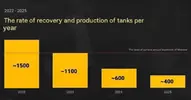
So what we see: from the second half of 2025, the current rate of replacement of tank losses of the Moscow army will hypothetically cover no more than 30% of the current losses at the front.
Therefore, the tank population will rapidly decline from 2025, which, in turn, will lead to a decrease in the involvement of equipment in assaults. And this, accordingly, will increase infantry losses during assaults, which will have corresponding consequences for the economy of the aggressor country.
Our conclusions are not a statement that Muscovy will be “without equipment”. Moscow is capable of producing and will be able to restore equipment from bases for some time. However, the intensity of the use of armored vehicles in assaults will continue to decrease due to the decline in the ability to replace losses. And this, in turn, will lead to a corresponding increase in infantry losses and an increase in the burden on the Muscovy budget for recruiting new soldiers and providing them.
In this case, the Moscow command will face a dilemma: either reduce the pace of the offensive to reduce the need for armored vehicles, or reduce the involvement of equipment in assaults and accept as a fact the increase in infantry losses with the corresponding military and economic consequences.
If the Moscow command attempts to maintain the current offensive pace by increasing the involvement of infantry, this will inevitably lead to a proportional increase in losses in the absence of a sufficient level of motorized support.
For example, by February 24, 2022, the Muscovite army had a staff number of about 3,200 tanks. From 2022 to 2024, Muscovite created an additional 11 divisions, which, according to calculations (approximately 187 to 210 tanks per division), should have brought the staff number of tanks to 5,000-5,100 units.
But according to OSINT data and comments from various intelligence agencies, including Ukrainian, there were about 2,200 tanks in Ukraine and near the borders at the beginning of 2024. Given the fact that at the end of the second half of 2024 the rate of losses exceeded the level of recovery, we can assume that as of 2025, the Moscow group has, according to our estimates, less than 2,000 tanks in Ukraine and near the borders. Or up to 40% of the required standard number.
In 2025, Moscow's industry will hypothetically produce, restore, or repair up to 400 units. That is, hypothetically, the group could have 2,400 tanks, but taking into account losses on the battlefield in 2025, if Moscow tries to maintain the pace of equipment deployment at the level of 2022/23/24, this will lead to the loss of 1,200 tanks in 2025, which will reduce the total number of tanks in combat units to 1,200 by the end of 2025 (i.e. 2,400, which could be, taking into account production, minus 1,200 tanks).
And this is only 23% of the required standard number of tanks. In the future, with each election cycle, the rate of tank production will decrease due to the poorer quality of the units that will be received for repair.
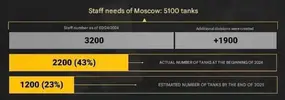
Since the so-called manufactured tanks in 80% of cases are tanks restored from storage bases, and only up to 20% are produced from scratch, this component will continue to be depleted. Of course, this will happen provided that the intensity and involvement of equipment are maintained.
The current production of tanks from scratch, according to the British International Institute for Strategic Studies, from May 17, 2022 to May 6, 2024, demonstrates that Muscovy produced 164 T-90M tanks. Or approximately 80 tanks per year.
These are the only tanks that Muscovy can produce relatively from scratch. Although even these 80 units per year may include a certain amount of modernization from the T-90, of which there were over 100 at storage bases, to the T-90M version.
As a result, the reduction in mechanization will lead to increased losses and increase pressure on the Moscow budget: from payments for the dead and wounded, the maintenance of demobilized soldiers who have suffered injuries, to the need to increase spending on recruiting new soldiers and providing them.
Therefore, we emphasize that it is important to consider the decline in Moscow's ability to restore lost equipment not in the context of "When the tanks run out, the war will end." No. This is the wrong approach. There will always be a certain number of tanks and other armored vehicles (because they are being produced), but their insufficient production rates to replace losses trigger other processes — from economic to political and social.
For example, out of a total of 4,716 tanks, about 650 are T-64s, which cannot be restored due to the need for components manufactured in Ukraine. The only chance is smuggling, but how widespread it can be, given that a certain number of T-64s are already in service with the Moscow army and require maintenance, is a debatable issue.
So there are about 4000+ tanks left. Of these, about 2/3 are tanks in an extremely terrible technical condition and therefore require restoration from scratch. Therefore, most of them will rather be used as donors, and only a small part will go for restoration as a last resort.
Thus, only about 1,200 tanks can be restored somehow after a major overhaul. This will take more time and money, but will be slightly faster than producing from scratch.
-
Lainaan myös artikkelista heidän arvionsa aktivoinnin hidastumisesta sekä sen vaikutuksista käytettävissä olevien panssarivaunujen kokonaismäärään:
At the end of 2024, the average production rate dropped to 50 tanks per month (up to 600 tanks per year), which is significantly lower than the rate of losses, given the need to replace 1,200-1,300 tanks per year.
The first observations for 2025 allow us to estimate a production rate of 30-35 units per month (or 360-400 tanks per year) with the potential for a sharp drop in the recovery rate at the end of the first half of 2025. The drop in the rate will be associated primarily with the exhaustion of T-80s suitable for recovery and modernization.

So what we see: from the second half of 2025, the current rate of replacement of tank losses of the Moscow army will hypothetically cover no more than 30% of the current losses at the front.
Therefore, the tank population will rapidly decline from 2025, which, in turn, will lead to a decrease in the involvement of equipment in assaults. And this, accordingly, will increase infantry losses during assaults, which will have corresponding consequences for the economy of the aggressor country.
Our conclusions are not a statement that Muscovy will be “without equipment”. Moscow is capable of producing and will be able to restore equipment from bases for some time. However, the intensity of the use of armored vehicles in assaults will continue to decrease due to the decline in the ability to replace losses. And this, in turn, will lead to a corresponding increase in infantry losses and an increase in the burden on the Muscovy budget for recruiting new soldiers and providing them.
In this case, the Moscow command will face a dilemma: either reduce the pace of the offensive to reduce the need for armored vehicles, or reduce the involvement of equipment in assaults and accept as a fact the increase in infantry losses with the corresponding military and economic consequences.
If the Moscow command attempts to maintain the current offensive pace by increasing the involvement of infantry, this will inevitably lead to a proportional increase in losses in the absence of a sufficient level of motorized support.
For example, by February 24, 2022, the Muscovite army had a staff number of about 3,200 tanks. From 2022 to 2024, Muscovite created an additional 11 divisions, which, according to calculations (approximately 187 to 210 tanks per division), should have brought the staff number of tanks to 5,000-5,100 units.
But according to OSINT data and comments from various intelligence agencies, including Ukrainian, there were about 2,200 tanks in Ukraine and near the borders at the beginning of 2024. Given the fact that at the end of the second half of 2024 the rate of losses exceeded the level of recovery, we can assume that as of 2025, the Moscow group has, according to our estimates, less than 2,000 tanks in Ukraine and near the borders. Or up to 40% of the required standard number.
In 2025, Moscow's industry will hypothetically produce, restore, or repair up to 400 units. That is, hypothetically, the group could have 2,400 tanks, but taking into account losses on the battlefield in 2025, if Moscow tries to maintain the pace of equipment deployment at the level of 2022/23/24, this will lead to the loss of 1,200 tanks in 2025, which will reduce the total number of tanks in combat units to 1,200 by the end of 2025 (i.e. 2,400, which could be, taking into account production, minus 1,200 tanks).
And this is only 23% of the required standard number of tanks. In the future, with each election cycle, the rate of tank production will decrease due to the poorer quality of the units that will be received for repair.

Since the so-called manufactured tanks in 80% of cases are tanks restored from storage bases, and only up to 20% are produced from scratch, this component will continue to be depleted. Of course, this will happen provided that the intensity and involvement of equipment are maintained.
The current production of tanks from scratch, according to the British International Institute for Strategic Studies, from May 17, 2022 to May 6, 2024, demonstrates that Muscovy produced 164 T-90M tanks. Or approximately 80 tanks per year.
These are the only tanks that Muscovy can produce relatively from scratch. Although even these 80 units per year may include a certain amount of modernization from the T-90, of which there were over 100 at storage bases, to the T-90M version.
As a result, the reduction in mechanization will lead to increased losses and increase pressure on the Moscow budget: from payments for the dead and wounded, the maintenance of demobilized soldiers who have suffered injuries, to the need to increase spending on recruiting new soldiers and providing them.
Therefore, we emphasize that it is important to consider the decline in Moscow's ability to restore lost equipment not in the context of "When the tanks run out, the war will end." No. This is the wrong approach. There will always be a certain number of tanks and other armored vehicles (because they are being produced), but their insufficient production rates to replace losses trigger other processes — from economic to political and social.
Tämä on karkeasti ottaen linjassa yllä olevan Jompyn taulukon kanssa, JOS oletetaan että armoured repair plant -pajojen pihoilla olisi hyväkuntoisia vaunuja noin 700 kpl TAI jos jokin määrä "poor" kategorian vaunuista on aktivoitavissa.
Covert Cabal ja highmarsed eivät ole vielä julkaisseet tuoreempaa, tarkempaa laskelmaa varastotukikohdista. Sellaista on lupailtu "kesäksi 2025", tosin highmarsed kommentoi muutama viikko sitten että vuoden 2025 osalta ei ole vielä julkaistu hyviä, tuoreita satelliittikuvia. Niiden saatavuus rajoittaa tietysti laskelman tekoa ja tuoreutta. Voi siis mennä kuukausi tai pari ennen kuin nähdään tuore laskelma ja silloinkin kannattaa varautua siihen että osa satelliittikuvista on keväältä 2025 (tai jopa vanhempia).
Viimeksi muokattu:
Nythän ei puhuta siitä mitä me lännessä tiedämme ja koemme. Zenäjällä on vuosikymmenet ja sadat pelätty ulkopuolista uhkaa oli siinä järkeä tai ei. Onhan se meille ihan selvää että länsi ei ole sinne hyökkäämässä mutta kummasti siellä ollaan ydinasevalmiudessa vuosikymmenestä toiseen ja puolustukseen laitetaan heti ruplaa kun vähänkään iivanan persaus kestää ja silläkään ei aina niin väliä kestääkö se vai ei koska omasta mielestään tuo itäinen kehitysmaa on globaali suurvalta josta pitää kaikin hinnoin kiinni. Ei tosiaan järkeä mutta näin siellä silti ajatellaan todistetusti.En osta eikä varmaan moni muukaan ajatusta, että ryssän tarvitsisi NATO-rajaa turvata. Koko sodan ajan raja on ollut tyhjä eikä tulevaisuudessakaan mitään uhkaa tältä suunnalta tule. Jos ei nyt ryssäkään pysty NATO-naapureitaan painostamaan, enää edes Suomea.
Kiinan rajan ryssä itsekin tietänee ongelmaksi. Ja voi hyvin käydäkin niin, että Taiwanin sijaan kiina päättää laajentua Siperian suuntaan.
Mahdollista jossain määrin ehkä jäädyttää sotaa, mutta Euroopan kapasiteetin noustessa se voi käydä kalliiksi ottaa murkulaa vastaan vaikka ei enää hyökkäsi.
Edelleen, tuon täytyy olla fuulaa, että ryssä oikeasti tuntisi noin. Noin toki sanotaan ja sillä tavoin perustellaan tarvetta milloin millekin.
Eksistentiaalinen uhka ryssän mafiahallinnolle on vapaa markkinatalous ja toimiva yhteiskunta. Jos Ukraina pääsee osaksi länttä ja alkaa rikastua Baltian ja Puolan tavoin, sitä voi olla lopulta hankalaa selittää puuceissä sammaleen pyyhkiville ryssille. Koska kuitenkin 40-miljoonaisen Ukrainan perheillä on paljon siteitä ryssälään ja niiden rikastuminen huomattaisiin kyllä.
Eiköhän siitä tule myös jotain reunaehtoja millainen sopimus ryssän olisi saatava, jotta homman voisi lopettaa. Jos Ukraina pääsee osaksi länttä, rikastumista ei voi estää.
Antares
Respected Leader
En ole hetkeen jakanut OSINT-ryhmä Oryxin sivun panssarivaunujen tappioiden numeroita taulukon muodossa, joten katsotaanpa miltä ne näyttävät tällä hetkellä.
Ensin T-54, T-55, T-62 ja T-64 perheiden tappiot:

Tässä T-72 perheen tappiot:

Tässä T-80 ja T-90 perheet sekä tuntemattomat ja koko tämän leveän taulukon summat:

-
Tässä puolestaan numeroiden jakautuminen vaunuperheiden kesken ja prosenttiosuudet kokonaismäärästä:
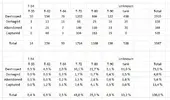
-
Näissä ei ole erikoisemmin kommentoitavaa, mitä nyt se että tappiot jatkavat kasvamistaan. T-72 perheen vaunut ovat tällä hetkellä johdossa, tosin T-80 on yliedustettuna kun verrataan sotaa edeltäneeseen aikaan. Tämä ei ole tietysti uusi tieto vaan ollut selvä jo vuodesta 2022 alkaen kun nähtiin miten kiivaasti ryssä aktivoi näitä vaunuja varastotukikohdistaan.
Oryxin listaa ylläpitävä Jacub Janovsky on kommentoinut aikaisemmin että hän arvelee valtaosan panssarivaunujen tappioista päätyvän heidän listoilleen, koska niitä käytetään niin lähellä etulinjaa ja siten ne tulevat kuvatuiksi ennemmin tai myöhemmin. Tästä huolimatta hän arveli 27.3.2024 että numerot voi kertoa kertoimella 1,1 koska ihan kaikista tappioista tuskin on saatu kuvatodisteita tai videoita. LÄHDE
Toiset, esimerkiksi puolalainen Jaroslaw Wolski ovat arvelleet että kerroin voisi olla jopa 1,2.
Eri OSINT-ryhmien numeroita tarkastelevat huomioivat useimmiten pelkästään tuhotut vaunut, koska "vaurioituneet, hylätyt tai kaapatut" vaunut voivat helposti palata alkuperäisen omistajan käyttöön tai päätyä toiselle osapuolelle. Tuhotut ovat tuhottuja ja siten varmasti menetettyjä.
Kertoimesta riippuen Oryxin mukaan ryssä on siis menettänyt tuhottuina 3 201 - 3 492 kpl panssarivaunuja.
HUOM: Oryxin numerot ovat olleet selvästi pienempiä kuin Andrew Perpetuan ryhmän laskemat, tämä on ollut selvää syksystä 2024 lähtien. Toisaalta Warspotting ryhmän numerot ovat olleet hieman pienemmät. Ukrainan ilmoittamat "päivän numerot" ovat tietysti suuremmat näihin OSINT-lähteisiin verrattuna.
Ensin T-54, T-55, T-62 ja T-64 perheiden tappiot:

Tässä T-72 perheen tappiot:

Tässä T-80 ja T-90 perheet sekä tuntemattomat ja koko tämän leveän taulukon summat:

-
Tässä puolestaan numeroiden jakautuminen vaunuperheiden kesken ja prosenttiosuudet kokonaismäärästä:

-
Näissä ei ole erikoisemmin kommentoitavaa, mitä nyt se että tappiot jatkavat kasvamistaan. T-72 perheen vaunut ovat tällä hetkellä johdossa, tosin T-80 on yliedustettuna kun verrataan sotaa edeltäneeseen aikaan. Tämä ei ole tietysti uusi tieto vaan ollut selvä jo vuodesta 2022 alkaen kun nähtiin miten kiivaasti ryssä aktivoi näitä vaunuja varastotukikohdistaan.
Oryxin listaa ylläpitävä Jacub Janovsky on kommentoinut aikaisemmin että hän arvelee valtaosan panssarivaunujen tappioista päätyvän heidän listoilleen, koska niitä käytetään niin lähellä etulinjaa ja siten ne tulevat kuvatuiksi ennemmin tai myöhemmin. Tästä huolimatta hän arveli 27.3.2024 että numerot voi kertoa kertoimella 1,1 koska ihan kaikista tappioista tuskin on saatu kuvatodisteita tai videoita. LÄHDE
Toiset, esimerkiksi puolalainen Jaroslaw Wolski ovat arvelleet että kerroin voisi olla jopa 1,2.
Eri OSINT-ryhmien numeroita tarkastelevat huomioivat useimmiten pelkästään tuhotut vaunut, koska "vaurioituneet, hylätyt tai kaapatut" vaunut voivat helposti palata alkuperäisen omistajan käyttöön tai päätyä toiselle osapuolelle. Tuhotut ovat tuhottuja ja siten varmasti menetettyjä.
Kertoimesta riippuen Oryxin mukaan ryssä on siis menettänyt tuhottuina 3 201 - 3 492 kpl panssarivaunuja.
HUOM: Oryxin numerot ovat olleet selvästi pienempiä kuin Andrew Perpetuan ryhmän laskemat, tämä on ollut selvää syksystä 2024 lähtien. Toisaalta Warspotting ryhmän numerot ovat olleet hieman pienemmät. Ukrainan ilmoittamat "päivän numerot" ovat tietysti suuremmat näihin OSINT-lähteisiin verrattuna.
Viimeksi muokattu:
Antares
Respected Leader
Sodan alkupuolella minulla oli tosiaan tapana päivittää tuota omaa seurantataulukkoani Oryxin numeroiden osalta, mutta tämä päivitystyö on jäänyt viimeisen parin vuoden aikana vähemmälle.
Huomasin kuitenkin että julkaisin tässä ketjussa 29.5.2023 silloiset numerot eli melko tasan kaksi vuotta sitten (LINKKI), joten tämä antaa tilaisuuden laskea, miten numerot ovat muuttuneet tällä aikavälillä eli 29.5.2023 - 22.5.2025.
Hyvä muistaa että ryssän hyökkäys alkoi 24.2.2022 eli 29.5.2023 julkaistun taulukon numerot edustavat sodan 15 ensimmäisen kuukauden tappioita, siten kun Oryxin ryhmä oli dokumentoinut ne 29.5.2023.
En käsittele 29.5.2023 julkaistuja numeroita sen tarkemmin, ne voi käydä vilkaisemassa tuon linkin takaa löytyvästä viestistä, mutta huomautan että ko. päivänä panssarivaunujen kokonaistappiot olivat Oryxin mukaan tasan 2 000 kpl.
Kuin sattumalta aikavälillä 29.5.2023 - 22.5.2025 panssarivaunujen kokonaistappiot olivat Oryxin mukaan 1 987 kpl eli melkein yhtä suuret, tosin aikaväli on 24 kuukautta eikä 15 kuukautta.
HUOM: tämä vertailu ei mene ihan 100% oikein koska Oryx, kuten muutkin OSINT-ryhmät tekevät korjauksia listoilleen sitä mukaa kun saavat uutta tietoa. Täten 29.5.2023 numerot edustavat parasta silloista tietoa, mutta tätä edeltävälle ajalle on voinut tulla uusia ajoitettuja tappioita sen jälkeen. Samoin aikaisemmin vaurioituneeksi, kaapatuksi tai hylätyksi merkityt vaunut ovat voineet vaihtaa eri kategoriaan kun on saatu uutta dataa. Tästä syystä tässä vertailussa näkyy muutama "negatiivinen muutos".
Laskin myös kullekin vaunutyypille / mallille sen tappioiden prosenttiosuuden kokonaismäärästä.
-
Ensin T-54, T-55, T-62 ja T-64 perheiden tappiot aikavälillä 29.5.2023 - 22.5.2025:

Tässä T-72 perheen tappiot aikavälillä 29.5.2023 - 22.5.2025:

Tässä T-80 ja T-90 perheet sekä tuntemattomat aikavälillä 29.5.2023 - 22.5.2025 ja koko tämän leveän taulukon summat:

-
Tässä puolestaan numeroiden jakautuminen vaunuperheiden kesken aikavälillä 29.5.2023 - 22.5.2025 ja prosenttiosuudet kokonaismäärästä:
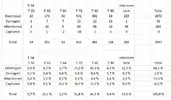
-
Tämä onkin paljon mielenkiintoisempi tarkastelu kuin pelkkä tuoreimpien numeroiden toteaminen.
Kuten sanottua, tämä ei ole täydellinen koska Oryx tekee listoilleen muutoksia ja korjauksia sitä mukaa kun saavat uutta dataa. Silti, tämä hyväksyen, uskon että tämä tarkastelu antaa yleiskuvan siitä mitä vaunutyyppejä ryssä on menettänyt viimeisen kahden vuoden aikana.
Hyvin merkittävää että T-80 perheen vaunuja on menetetty eniten, vaikka koko sodan osalta T-72 perhe onkin edellä. Vastaavasti hyvin shokeeraavaa että modernisoimaton T-80BV muodostaa 19,43% viimeisen kahden vuoden kokonaistappioista!
Hyökkäyksen alkamisen jälkeen käyttöönotetut modernisoinnit (T-62M Obr. 2022, T-62MV Obr. 2022, T-72B Obr. 2022, T-72B3 Obr. 2022, T-72B3 Obr. 2025, T-80BV Obr. 2022 ja T-80BVM Obr. 2022) sekä T-90M yhteenlaskettuna saadaan:
2,26 + 0,50 + 8,10 + 4,83 + 0,05 + 5,03 + 3,77 + 5,84 = 30,38%
Tämä prosenttiluku tarkoittaa Oryxin laskemista kokonaistappioista aikavälillä 29.5.2023 - 22.5.2025 hieman yli 600 kpl panssarivaunuja.
Tästä nähdään myös että viimeisen kahden vuoden aikana kärsityistä tappioista 69,62% on siis joko sotaa edeltäneiden vuosien aikana modernisoituja vanhoja vaunuja tai Neuvostoliiton aikana valmistettuja, myöhemmin peruskorjattuja mutta ei-modernisoituja vaunuja.
HUOM: taulukossa on myös eri vaunuperheiden "tuntemattomia" joita ei ole kyetty tunnistamaan, mikä sotkee kokonaisuutta hieman. Tuntemattomien osuus kokonaismäärästä on 23,19% eli harmittavan suuri mutta minkäs teet. Toki osa näistä on kyetty tunnistamaan tiettyyn vaunuperheeseen joten nämä voisi halutessaan kokeilla jyvittää eri mallien alle todennäköisyyksien perusteella, mutta 14,49% on täysin tunnistamattomia eli ei voida jakaa edes vaunuperheisiin.
Huomasin kuitenkin että julkaisin tässä ketjussa 29.5.2023 silloiset numerot eli melko tasan kaksi vuotta sitten (LINKKI), joten tämä antaa tilaisuuden laskea, miten numerot ovat muuttuneet tällä aikavälillä eli 29.5.2023 - 22.5.2025.
Hyvä muistaa että ryssän hyökkäys alkoi 24.2.2022 eli 29.5.2023 julkaistun taulukon numerot edustavat sodan 15 ensimmäisen kuukauden tappioita, siten kun Oryxin ryhmä oli dokumentoinut ne 29.5.2023.
En käsittele 29.5.2023 julkaistuja numeroita sen tarkemmin, ne voi käydä vilkaisemassa tuon linkin takaa löytyvästä viestistä, mutta huomautan että ko. päivänä panssarivaunujen kokonaistappiot olivat Oryxin mukaan tasan 2 000 kpl.
Kuin sattumalta aikavälillä 29.5.2023 - 22.5.2025 panssarivaunujen kokonaistappiot olivat Oryxin mukaan 1 987 kpl eli melkein yhtä suuret, tosin aikaväli on 24 kuukautta eikä 15 kuukautta.
HUOM: tämä vertailu ei mene ihan 100% oikein koska Oryx, kuten muutkin OSINT-ryhmät tekevät korjauksia listoilleen sitä mukaa kun saavat uutta tietoa. Täten 29.5.2023 numerot edustavat parasta silloista tietoa, mutta tätä edeltävälle ajalle on voinut tulla uusia ajoitettuja tappioita sen jälkeen. Samoin aikaisemmin vaurioituneeksi, kaapatuksi tai hylätyksi merkityt vaunut ovat voineet vaihtaa eri kategoriaan kun on saatu uutta dataa. Tästä syystä tässä vertailussa näkyy muutama "negatiivinen muutos".
Laskin myös kullekin vaunutyypille / mallille sen tappioiden prosenttiosuuden kokonaismäärästä.
-
Ensin T-54, T-55, T-62 ja T-64 perheiden tappiot aikavälillä 29.5.2023 - 22.5.2025:

Tässä T-72 perheen tappiot aikavälillä 29.5.2023 - 22.5.2025:

Tässä T-80 ja T-90 perheet sekä tuntemattomat aikavälillä 29.5.2023 - 22.5.2025 ja koko tämän leveän taulukon summat:

-
Tässä puolestaan numeroiden jakautuminen vaunuperheiden kesken aikavälillä 29.5.2023 - 22.5.2025 ja prosenttiosuudet kokonaismäärästä:

-
Tämä onkin paljon mielenkiintoisempi tarkastelu kuin pelkkä tuoreimpien numeroiden toteaminen.
Kuten sanottua, tämä ei ole täydellinen koska Oryx tekee listoilleen muutoksia ja korjauksia sitä mukaa kun saavat uutta dataa. Silti, tämä hyväksyen, uskon että tämä tarkastelu antaa yleiskuvan siitä mitä vaunutyyppejä ryssä on menettänyt viimeisen kahden vuoden aikana.
Hyvin merkittävää että T-80 perheen vaunuja on menetetty eniten, vaikka koko sodan osalta T-72 perhe onkin edellä. Vastaavasti hyvin shokeeraavaa että modernisoimaton T-80BV muodostaa 19,43% viimeisen kahden vuoden kokonaistappioista!
Hyökkäyksen alkamisen jälkeen käyttöönotetut modernisoinnit (T-62M Obr. 2022, T-62MV Obr. 2022, T-72B Obr. 2022, T-72B3 Obr. 2022, T-72B3 Obr. 2025, T-80BV Obr. 2022 ja T-80BVM Obr. 2022) sekä T-90M yhteenlaskettuna saadaan:
2,26 + 0,50 + 8,10 + 4,83 + 0,05 + 5,03 + 3,77 + 5,84 = 30,38%
Tämä prosenttiluku tarkoittaa Oryxin laskemista kokonaistappioista aikavälillä 29.5.2023 - 22.5.2025 hieman yli 600 kpl panssarivaunuja.
Tästä nähdään myös että viimeisen kahden vuoden aikana kärsityistä tappioista 69,62% on siis joko sotaa edeltäneiden vuosien aikana modernisoituja vanhoja vaunuja tai Neuvostoliiton aikana valmistettuja, myöhemmin peruskorjattuja mutta ei-modernisoituja vaunuja.
HUOM: taulukossa on myös eri vaunuperheiden "tuntemattomia" joita ei ole kyetty tunnistamaan, mikä sotkee kokonaisuutta hieman. Tuntemattomien osuus kokonaismäärästä on 23,19% eli harmittavan suuri mutta minkäs teet. Toki osa näistä on kyetty tunnistamaan tiettyyn vaunuperheeseen joten nämä voisi halutessaan kokeilla jyvittää eri mallien alle todennäköisyyksien perusteella, mutta 14,49% on täysin tunnistamattomia eli ei voida jakaa edes vaunuperheisiin.
Viimeksi muokattu:
putkirassi
Majuri
Vaunut ei venäjältä lopu. Vaunujen käyttö on muuttunut , jolloin niitä on tarpeeseen.Toki käytön muutos osittain johtuu kaluston rakenteen muutoksesta, mutta taistelutavan muutos, dronien roolin raju noste, tekee panssarivaunusta helpon maalin. Kiinalainen mopon mukana menee 1 , vaunun mukana vaunullinen. Ei ole panssarilautta enää pelote.
Juurikin näin. Sitä pohditaan ees ja taas paljonko ryssällä on tankkeja - mutta mikä merkitys tällä määrällä on. Ja minkälainen on niiden miehistö tai kenttäjohto. Se tuhansien vaunujen ylivoima on ollut tähänkin asti.Vaunut ei venäjältä lopu. Vaunujen käyttö on muuttunut , jolloin niitä on tarpeeseen.Toki käytön muutos osittain johtuu kaluston rakenteen muutoksesta, mutta taistelutavan muutos, dronien roolin raju noste, tekee panssarivaunusta helpon maalin. Kiinalainen mopon mukana menee 1 , vaunun mukana vaunullinen. Ei ole panssarilautta enää pelote.
tankki-tapsa
Kenraali
Ja Rooman clubi tiesi jo 80 vuotta sitten että öljy loppuu 40 vuoden kuluttua! Koko maailmasta!!!1Jep, enää vajaa 30 vuotta ja sitt se on siinä.
-TripleX-
Respected Leader
Lipetskin alueella jonkinlaiseen kemiantehtaaseen tai tuotantolaitokseen on iskenyt drooneja viime yönä. Ilmeisesti siellä on koottu tai valmistettu akkuja drooneihin sekä muihin laitteisiin, todennäköisesti paljon muutakin.
Tämän mukaan myös aikaisemmin olisi isketty Ryazanin öljyn jalostamolle ja ainakin FIRMSissä joitakin paloja on näkynyt.
Tämän mukaan myös aikaisemmin olisi isketty Ryazanin öljyn jalostamolle ja ainakin FIRMSissä joitakin paloja on näkynyt.
Viimeksi muokattu:
-TripleX-
Respected Leader
Jalkaväki miehiä lämmittää aina kun raketinheitin lähtee maata kiertävälle radalle, ryssien Grad näyttää mallia Pokrovskin suunnalla.
Vähän aiemmin pitkän matkan droonit ovat iskeneet Tulassa Rostecin konepajaan joka valmistaa osia muun muassa raketinheittimiin.
Drooni-iskut ovat näköjään palanneet ohjelmaan Ukrainan toimestakin.
Vähän aiemmin pitkän matkan droonit ovat iskeneet Tulassa Rostecin konepajaan joka valmistaa osia muun muassa raketinheittimiin.
Drooni-iskut ovat näköjään palanneet ohjelmaan Ukrainan toimestakin.
Viimeksi muokattu:

